Osha safety standards especially for roof fall protection can be a source of confusion for many industrial companies.
Osha regulations roof access.
How far the d ring shifts and the harness stretches when it supports the full weight of a fallen worker including the weight of tool belts and other attached equipment or tools.
1910 23 osha s requirements for locking type snaphooks on pole strap systems 03 13 1996 1910 23 platforms and ladders on communication towers.
This means that the building owner needs to work with their maintenance staff to develop a safe work plan for any work on the roof.
If the parapet is continuous the access level is the top of the parapet.
Two osha standards can apply 29 cfr 1910 which governs general industry safety standards and 29 cfr 1926 which governs construction sites specifically.
The osha general industry standards exclude construction as well as agriculture and marine industries which also have their own standards but both standards can sometimes apply to the same.
Side rails of through or side step fixed ladders must extend 42 inches 1 1 m above the top level or landing platform served by the ladder.
Parapet ladders must have an access level at the roof if the parapet is cut to permit passage through it.
Osha requires that this distance be no greater than 3 5 feet 29 cfr 1926 502 d 16 iv but it may be less for some pfas equipment.
Osha considers it a working area.
More importantly the risk of injury or even death from this hazard creates a serious safety and liability concern for building owners.

